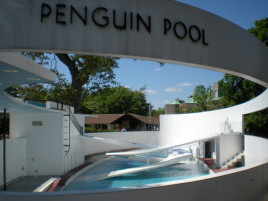From his arrival in Britain in 1931 the Georgian-born architect Berthold Lubetkin brought his experience of the Soviet revolution in 1917 and the turbulent debates about art and politics in Paris in the 1920s to generate ideas about architecture and social commitment. His work developed the most significant Constructivist architecture in Britain for the next two decades. His theoretically informed modernist design aspired to be an agent for human betterment; conceiving of architecture as “a potent weapon, a committed driving force on the side of enlightenment, aiming, however indirectly, at the transformation of our present make-believe society where images outstrip reality and rewards outpace achievement”.
This article by Professor Rod Stoneman, Director of the Huston School of Film and Digital Media, NUI Galway was first published on The Column website as part of their Struggle + Space series.
Establishing the company Tecton with a group of like-minded architects, his philosophy and practice sought to sustain a dynamic tension between formal design and usage. It refused a purist version of functionalism which subordinated all projects to utilitarian ends – buildings as instruments for an economic purpose. Today it stands against the formalist trends of unrestrained exhibitionism which focus on image, decoration and surface – characteristic of the contemporary currents of ‘starchitecture’.
In addition to a circus club and flats in the Avenue de Versailles, Paris he built a TB clinic and housing in London and several inventive projects in zoos including Whipsnade and Dudley. The opening of a new Penguin Pool in London Zoo in Regent’s Park in 1934 had considerable impact. Originally labelled the ‘Penguin Pond’, it constructed graceful pathways for the penguins to descend from their nesting boxes to the pool. Reinforced concrete is suspended in the air and the oval curves of interlocking ramps curve downwards gently.
Lubetkin felt that the strong formal play proclaimed the certainty of order over the forces of chaos: “The bare eloquence of geometric regularities affirm Man’s ability to explain and predict […] and asserts itself against subjectivity, equivocation and arbitrariness.” These aims are part of a politicised aesthetic for architecture which connected with a recharged mood of determination to change the fabric of society.
In The Soul of Man under Socialism (1891) Oscar Wilde had written “A map of the world that does not include Utopia is not worth even glancing at…” and modernity was integral to realising a better future. At the time some of the responses to the Penguin Pool connected the design with its social potential; a magazine article from Mother and Child asked “How many citizens of London have brooded over the railings of that pool, envying the penguins as they streak through the blue water or plod up the exquisite incline of the ramp – and have wondered sadly why human beings cannot be provided, like the penguins, with an environment so well adapted to their needs?”
Lubetkin designed public housing, a health centre, and a large scale bomb shelter in the Finsbury area. During the long siege of Leningrad during World War II the Foreign Office proposed a monument to Lenin in Holford Square, Finsbury, where he had lived from 1902-03. The square had been damaged by heavy bombing during the Blitz but Lubetkin designed a bust of Lenin and plaque opened by the Foreign Secretary and the Russian Ambassador in May 1942. It was attacked and defaced and had to be protected with a 24 hour police guard. Lubetkin had the memorial buried under the central core of the staircase in the nearby social housing scheme he designed; originally to be named Lenin Court but changed to Bevin Court after the Labour politician who became a determinedly anti-communist Foreign Secretary at the start of the Cold War. To this day it underpins the social heart of the building, perhaps waiting for a more promising future.
Lubetkin_ready
The prevarication, blockage and compromise Lubetkin encountered with a succession of projects led to his premature retirement from architectural practice in 1950, he bought a pig farm near Bristol.
However, back in London Zoo, apparently, the suspended slopes never really worked for the penguins, who began to develop arthritis in their feet. It seems that they took a strong liking to the duck pond they were temporarily taken to in 2004 and since 2011 have been relocated in the Zoo’s new Penguin Beach, a large scale ₤2 million spectacular environment where they may be observed from all angles above and below water. Protected as a listed building by the Department of the Environment, the Lubetkin Penguin Pool has been re-designated a water feature.
In this penguin-sized tale is the wider story of the failure of modernism as a social project, linked to the wider historical defeat of the Left. But the water feature remains, detached from its social function, serving to remind us of the aesthetic and political ambitions of modernism.
Photo of Penguin Pool: Kat Sommers
Tags: Architecture, Communism, London Zoo, Lubetkin, modernism, Penguin Pool, Socialism


Subscribe with…